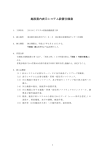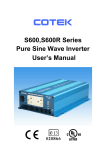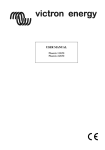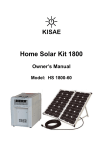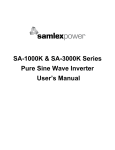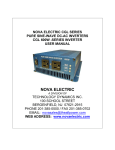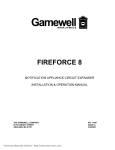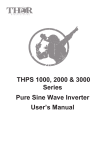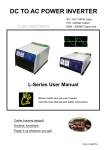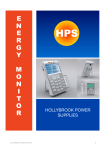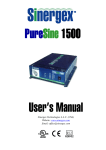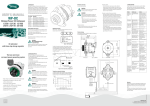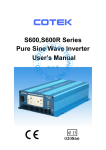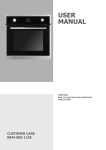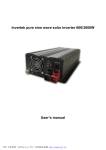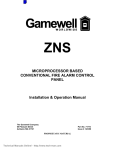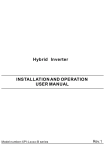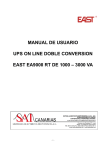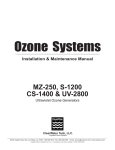Download AEP-3000R Series Rackmount Pure Sine Wave Inverter User Manual
Transcript
AEP-3000R Series Rackmount Pure Sine Wave Inverter User Manual 200 Butterfield Drive, Ashland, MA 01721, Tel: (508)881-7330, Fax: (508)231-0861 Website: http://www.schaeferpower.com, Email: [email protected] January 2007 Table of Contents 1. Features 1-1 Applications 1-2 Electrical performance 1-3 Mechanical drawings 1-4 Rear panel 2 3 4 5 2. Introduction 2-1 Front panel operations 2-2 Rear panel operations 2-3 Installation 2-4 Quick hook up and testing 2-5 AC safety grounding 2-6 Making DC wiring connections 2-7 Inverter operation 2-8 Output power 2-9 Cooling fan operation 5-6 7 8 8-9 9-10 10-11 11-13 13-14 14 3. Maintenance ……………………………………………………………….………………. 14 4. Troubleshooting Guide …..……………………………………………………………… 15 5. Warranty …………………………………………………………………………..……….. 16 6. Important Safety Instructions 6-1 General safety precautions 6-2 Precautions when working with batteries 16 17 7. Appendix A 7-1 Dip switch settings 7-2 Variable output adjustment 17 17 1 1/24/2007 1. Features: Pure sine wave output (THD < 3%) Auto bypass function Output frequency: 50 / 60Hz switch selectable RS–232C interface / remote control port / wire connection to PC Wired remote control (optional) Thermostatically controlled cooling fan Advanced microprocessor design Protection : Input low voltage Overload Short circuit Low battery alarm Input over voltage Over temperature 1-1 Applications 1-1-1 Power tools – circular saws, drills, grinders, sanders, buffers, landscaping tools, air compressors. 1-1-2 Office equipment – computers, printers, monitors, facsimile machines, scanner. 1-1-3 Central office – data centers 1-1-4 Factory automation – backup control systems 1-1-5 Household items – vacuum cleaners, fans, fluorescent and incandescent lights, shavers, sewing machines, 1-1-6 Kitchen appliances – microwave ovens, refrigerators and freezers, coffee makers, blenders, ice markers, toasters. 1-1-7 Industrial equipment – metal halide lamp, high pressure sodium lamp. 1-1-8 Home entertainment/electronics - television, VCRs, video games, stereos, musical instruments, satellite equipment. 2 1/24/2007 1-2 Electrical Performance Specification AEP-3000R Series Model Number AEP-3000R- AEP-3000R- AEP-3000R- AEP3000R- AEP-3000R- AEP-3000R121 241 481 122 242 482 Continuous Output Power 2250W (3KVA) 2400W (3KVA) 2550W (3KVA) 2100W (3KVA) 2400W (3KVA) 2550W (3KVA) Surge Rating Input Voltage Output Voltage Regulation 2475W/1Min 2640W/1Min 2805W/1Min 2475W/1Min 2640W/1Min 2805W/1Min 2700W/20Sec 2880W/20Sec 3060W/20Sec 2700W/20Sec 2880W/20Sec 3060W/20Sec 12V 24V 48V 12V 24V 48V 100 /110/115 /120V RMS ±3% 200 / 220 / 230 / 240V RMS ±3% Frequency 50/60Hz ± 0.05% (Switch Selectable) Peak Output Current 30A 15A Efficiency (full load) 84% 86% 87% 85% 88% 90% No Load Current Draw 1.54A 0.82A 0.37A 2.3A 1.42A 0.6A Output Waveform R Load Sine Wave <3% THD Output Voltage Range Input Voltage Regulation VAC 100~120V (Adjustable) VAC 200~240V (Adjustable) 10-16 20-32 42-62 10-16 20-32 42-62 VDC VDC VDC VDC VDC VDC Protection Overload, Short Circuit, Reverse Polarity (Fuse), Over/Under Input Voltage, Over Temperature. Digital Display OVP : UVP : OTP : OLP : VAC : AMP : WATT : VDC : TEMP : Hz Interface Control Port RS-232C With Baud Rate 2400,4800, 9600, 19200 (Switch Selectable) Remote Control Unit Optional AC Input AC110V (90~130V) AC220V (180~260V) AC Frequency 50Hz ~ 60 Hz 50Hz ~ 60 Hz Bypass 4~6ms 4~6ms Operating Temperature Range -30 to +60°C (-22 to +140°F) Storage Temperature Range -30° to +70°C (-22 to +158°F) Dimensions (L x W x H) 435 x 424 x 88.4 mm (17.12” x 19” x 3.48”) Weight 9.8 kgs (21.60 lbs.) 3 1/24/2007 1-3 Mechanical Drawings 4 1/24/2007 1-4 Rear Panel 2. Introduction: The AEP-3000R Series is part of Schaefer’s line of advanced technology, pure sine wave DC/AC power inverters. For optimum performance, the instruction manual should be read to ensure proper installation and use of the AEP-3000R. 2-1 Front Panel Operation: 2-1-1 Front view: 2-1-2 ON / OFF Switch: Please keep the Power ON/OFF switch in the OFF position during installation. 5 1/24/2007 2-1-3 Function Key When sequentially pushing the “Function Key”, the screen will display various status items such as output voltage, output current, output power, etc. When a malfunction occurs, the corresponding error will be displayed on the screen. 2-1-4 AC Outlet (sockets available; the Universal socket is standard with the AEP-3000R): 6 1/24/2007 2-2 Rear Panel Operation: 2-2-1 Ventilation openings: Do not obstruct; allow at least 3 inches for airflow. 2-2-2 Battery terminals: Connect to a 12VDC/24VDC/48VDC battery or other 12VDC/24VDC/48VDC power source. Red [+] is positive; black [-] is negative. Reverse polarity connection will blow the internal fuse and may damage inverter permanently. WARNING! Do not connect the 12VDC model to a 24VDC battery. The unit will be destroyed immediately! 2-2-3 RS-232C: Connect to remote control unit (optional accessory) or connect to computer for remote control working status. 2-2-4 Connect chassis ground terminal to earth or to vehicle chassis using # 8 AWG wire. WARNING! Operation of the inverter without a proper ground connection may result in an electrical safety hazard WARNING! Shock Hazard! Before proceeding, carefully check the AEP-3000R inverter is NOT connected to any batteries and is disconnected from any electrical source. Do not connect the output terminals of the AEP-3000R to an incoming source at this time. 7 1/24/2007 2-3 Installation: Where to install: The power inverter should be installed in a location that meets the following requirements: 2-3-1 Dry: Do not allow water to drip or splash on the inverter. 2-3-2 Cool: Ambient air temperature should be between 0C and 40C. 2-3-3 Safe: Do not install in a battery compartment or other areas where flammable fumes may exist, such as fuel storage areas or engine compartments. 2-3-4 Ventilated: Allow at least three inches of clearance around the inverter for air flow, ensuring that the ventilation openings on the rear and bottom of the unit are not obstructed. 2-3-5 Dust Free: Do not install the AEP-3000R Inverter in a dusty environment where dust, wood particles or other filings/shavings are present that may be pulled into the unit when the cooling fan is operating. 2-3-6 Close to Batteries: Avoid excessive cable lengths but do not install the AEP-3000R Inverter in the same compartment as batteries. Use the recommended wire lengths and sizes (see section 2-6). Avoid mounting the AEP-3000R Inverter where it may be exposed to the gases produced by the battery. Prolonged exposure to these corrosive gases will damage the AEP-3000R Inverter. 2-4 Quick Hook Up and Testing: 2-4-1 Unpack and inspect the power inverter, verifying that the power switch in the OFF position. 2-4-2 Connect the cables to the power input terminals on the rear panel of the power inverter. The red terminal is positive (+) and black terminal is negative (-). Insert the cables into the terminals and tighten the nut to securely clamp the wires. WARNING! You may observe a spark when you make this connection as current may flow to charge the capacitors in the inverter. Do not make this connection in the presence of flammable fumes. Explosion or fire may result! 2-4-3 Before proceeding, confirm that your cable is connected from the negative terminal of inverter to the negative output of your power source. 8 1/24/2007 2-4-4 Connect the cable from the positive terminal of the inverter to the positive terminal of the power source. Make a secure connection. CAUTION! Reverse polarity connection will blow a fuse in the inverter and may cause damage. Damage caused by reverse polarity connection is not covered by our warranty WARNING! Make sure that all DC connections are tight (torque to 9-10 foot pounds). Loose connections will overheat and could result in a potential hazard 2-4-5 Set the power switch to the ON position; you will hear a beeping sound, while the display shows the word “ASIAN” twice. After that, you will hear a continuous tone from the internal alarm. Finally, the AC voltage shows on the display, signaling that the inverter has completed the start up operation. 2-4-6 Set the power switch to the OFF position; the device will shut down completely. 2-4-7 Please use a power meter to accurately measure the true output R.M.S. voltage of inverter. 2-5 AC Safety Grounding: During the AC wiring installation, AC input and output ground wires are connected to the inverter. The AC input ground wire must connect to the incoming ground from your AC utility source. The AC output ground wire should go to the grounding point for your loads (for example, a distribution panel of bus chassis). 2-5-1 Neutral Grounding (GFCI’s): 2-5-1-1 120VAC Models: The neutral conductor of the AC output circuit of the AEP-3000R Inverter is automatically connected to the safety ground during inverter operation. This conforms to national electrical code requirements stating that separately derived AC sources (such as inverters and generators) have their neutral conductors tied to ground in the same way that the neutral conductor from the utility is tied to 9 1/24/2007 ground at the GFCI breaker panel. For models configured with a transfer relay, while AC utility power is present and the inverter is in bypass mode, this connection (neutral of the inverter’s AC output to input safety ground) is not present so that the utility neutral is only connected to ground at your breaker panel, as required. 2-5-1-2 230VAC Models: There is no connection made inside the AEP-3000R Inverter from either the line or neutral conductor to the safety ground. WARNING! Do not operate the power inverter without connecting it to ground. Electrical shock hazard may result. 2-6. Making DC Wiring Connections: Follow this procedure to connect the battery cables to the DC input terminals on the AEP-3000R Inverter. Your cables should be as short as possible (ideally, less than 10 feet / 3 meters) and large enough to handle the required current in accordance with the electrical codes or regulations applicable to your installation. Cables that are not an adequate gauge (too narrow) or are too long will cause decreased inverter performance such as poor surge capability and frequent low input voltage warnings and shutdowns. These low input voltage warnings are due to DC voltage drop across the cables from the inverter to the batteries. The longer and narrower these cables, the greater the voltage drop. WARNING! The installation of a fuse must be on positive cable. Failure to place a fuse on “+ “cables running between the inverter and battery may cause damage to the inverter and will void warranty. Increasing your DC cable size will help improve the situation. We recommend the following cables for optimum inverter performance. Use only high quality copper wiring and keep cable length short (from 3-6 feet). 10 1/24/2007 Model No Wire AWG Inline Fuse AEP-3000R-121 #4/0 400A AEP-3000R-122 #4/0 400A AEP-3000R-241 #2/0 200A AEP-3000R-242 #2/0 200A AEP-3000R-481 #1/0 100A AEP-3000R-482 #1/0 100A 2-7 Inverter Operation: To operate the power inverter, turn it on using the ON/OFF switch on the front panel. The power inverter is now ready to deliver AC power to your loads. If you are operating several loads from the power inverter, turn them on separately after the inverter has been turned on. This will ensure that the power inverter does not have to deliver the starting currents for all the loads at once. 2-7-1 Controls and indicators: The ON / OFF switch turns the control circuit in the power inverter on and off. The AEP-3000R Inverter operates from an input voltage ranging from: 10.5 to 15.0 VDC for 12VDC models 21.0 to 30.0 VDC for 24VDC models 42.0 to 60.0 VDC for 48VDC models The AEP-3000R Inverter will indicate high and low DC voltage conditions as follows: Model Dc Input over Dc Input over Dc Input Dc Input under voltage under voltage alarm voltage shut-down voltage alarm shut-down AEP-3000R-121 AEP-3000R-122 16.0VDC 15.5VDC 10.5VDC 10.0VDC 32.0VDC 31.0VDC 21.0VDC 20.0VDC 62.0VDC 61.0VDC 43.0VDC 42.0VDC AEP-3000R-241 AEP-3000R-242 AEP-3000R-481 AEP-3000R-482 11 1/24/2007 2-7-2 Output Voltage Indicator: VAC LED illuminated. Display indicates output voltage value. 2-7-3 Output Current Indicator: AMP LED illuminated. Display indicates output current value. 2-7-4 Output Watts Indicator: Watts LED illuminated. Display indicates Watts value. 2-7-5 Input DC Voltage Indicator: VDC LED illuminated. Display indicates input DC voltage value 2-7-6 Temperature Indicator: TEMP LED illuminated. Display indicates internal operating temperature value. 2-7-7 Output Frequency DC Indicator: Hz LED illuminated. Display indicates output frequency value The accuracy of the six display functions is below: Functions Ranges Accuracy VAC AMP WATT VDC 100-120 200-240 10-16 0-30A 0-3KW VAC VAC VDC ± 1% ± 1% ± 1% ± 3% ± 2% TEMP Frequency 20-32 42-62 0-120 VDC VDC 50Hz 60Hz ± 2% ±0.01 ±0.01 ± 2% ± 1% 2-7-8 Over Voltage Protection Indicator: (OVP) The over voltage indicator indicates that the power inverter has shut itself down because its input voltage exceeded the limits of the inverter (see Page 12). 12 1/24/2007 2-7-9 Under Voltage Protection Indicator: (UVP) The under voltage indicator indicates that the power inverter has shut itself down because its input voltage fell below the limits of the inverter (see Page12). 2-7-10 Over Temperature Protection Indicator: (OTP) The over temperature indicator indicates that the power inverter has shut itself down because the inverter has overheated. The power inverter may overheat because it has been operated at power levels above its rating or because it has been installed in a location which does not allow it to dissipate heat properly. The power inverter will automatically restart, once the temperature has decreased. 2-7-11 Over Load Protection Indicator: (OLP) The overload indicator indicates that the power inverter has shut itself down due to the output being overloaded. The inverter must be manually restarted. Turn off the AEP-3000R inverter, correct the fault condition, then, turn the AEP-3000R inverter back on. 2-8 Output Power: The AEP-3000R inverter will operate most AC powered devices within its power rating. When deeming whether a microwave oven can be operated by the AEP-3000R inverter, remember that the power commonly advertised for microwave ovens is the cooking power, not the power actually consumed by the microwave oven. The microwave oven will consume 40% to 100% more than its advertised cooking power. Check the rating sticker on the back of the oven to determine its actual power requirements. The AEP-3000R inverter will operate small microwave oven with a surge rating of less than 3300 watts. 13 1/24/2007 Some induction motors used in refrigerators, freezers, pumps and other motor operated equipment require very high surge currents to start. The AEP-3000R may not be able to start some of these motors even though their rated current requirement is within the power inverter. If the motor will not start, observe the battery voltage indicator while trying to start the motor. If the battery voltage indicator drops below 11 volts while inverter is attempting to start the motor, this may be the cause. Ensure that the battery connections are good and the battery is fully charged. If the connections are good and the battery is fully charged, but the voltage still drops below 11 volts, you may need to use a larger battery. 2-9 Cooling Fan Operation: The AEP-3000R’s cooling fan operates by detecting output power and over temperature conditions of the inverter. Upon starting the inverter, with the output power is 300W, the cooling fan remains off, complying with energy savings specifications. After the output power exceeds 300W, the cooling fan will turn on to decrease the internal temperature. If the ventilation opening is obstructed, the inverter will enter over temperature protection mode (OTP). The cooling fan will continue working to drop the inner temperature. When the internal temperature decreases sufficiently, the inverter will turn on automatically. 3. Maintenance: Very little maintenance is required to keep your inverter operating properly. You should clean the exterior of the unit periodically with a dry cloth to prevent accumulation of dust and dirt. At the same time, tighten the Screws on the DC input terminals. 14 1/24/2007 4. Troubleshooting Guide: Problem and Symptoms Low output voltage (110V: 95-105VAC 220V: 190-210VAC) Load Display OLP flash. No output voltage Fault input voltage. No output voltage Over Temp indicator Load less than 1500W No output voltage, Over load indicator Possible Cause Using average voltmeter Solution reading Use true RMS reading meter and cable( see page 9, Point 2-4-7 of manual) Over load Reduce load. Low/High input voltage Recharge battery, check connections and cable. (see page 11) Thermal shutdown Improve ventilation , Make sure ventilation openings in inverter are not obstructed , Reduce ambient temperature. Short circuit or wiring error Check AC wiring for short Very high power load circuit or improper polarity (hot and neutral reversed ) Remove load. A common problem with inverter operation is television interference. Operation of the power inverter can interfere with television reception on some channels. In this situation, the following steps may help to alleviate the problem: Make sure that the chassis ground lug on the back of the power inverter is solidly connected to the ground system of your vehicle, boat or home. Do not operate high power loads with the power inverter while watching television. Make sure that the antenna feeding your television provides an adequate (“snow free”) signal and that you are using good quality cable between the antenna and the television. Move the television as far away from the power inverter as possible. Keep the cables between the battery and the power inverter as short as possible and twist them together about 2 to 3 twists per foot. This minimizes radiated interference from the cables. WARNING Do not open or disassemble the AEP-3000R Inverter, Attempting to service the unit yourself may result in a risk of electrical shock or fire. 15 1/24/2007 5. Warranty: We warranty this product against defects in materials and workmanship for a period of 24 months from the date of purchase and will repair or replace any defective power inverter when directly returned (shipping prepaid) to us. This warranty will be considered void if the unit has suffered any obvious damage by natural and man-made factors or has been internally or externally altered. The warranty does not cover damage arising from improper use such as plugging the unit into an unsuitable power source, attempts to operate products with excessive power consumption requirements or use in unsuitable environments. This is the only warranty that the company makes. No other warranties are expressed or implied including warranties of merchantability and fitness for a particular purpose. Repair or replacement are the sole remedies and the company shall not be liable for damages, whether direct, incidental, special or consequential, caused by negligence or other fault. 6. Important Safety Instructions WARNING! Before installing and using your AEP-3000R inverter, be sure to read and save these safety instructions. 6-1 General Safety Precautions 6-1-1 Do not expose the AEP-3000R Inverter to rain, snow, spray, bilge or dust. To reduce risk of hazard, do not cover or obstruct the ventilation openings. Do not install the AEP-3000R Inverter in a zero-clearance compartment. Overheating may result. 6-1-2 To avoid the risk of fire and electronic shock, make sure that existing wiring is in good electrical condition and that wire size is not undersized. Do not operate the AEP-3000R Inverter with damaged or substandard wiring. 6-1-3 This product contains components which can produce arcs or sparks. To prevent fire or explosion, do not install in compartments containing batteries or flammable materials or in locations which require ignition protected equipment. These locations include gasoline powered machinery, fuel tanks and joints, fittings or other connections between components of a fuel system. 16 1/24/2007 6-2 Precautions When Working with Batteries 6-2-1 If battery acid contacts skin or clothing, wash immediately with soap and water. If acid enters eye, immediately flush with running cold water for at least 20 minutes and seek medical attention immediately. 6-2-2 NEVER smoke or allow a spark or flame in the vicinity of battery or engine compartment. 6-2-3 Do not drop a metal tool on the battery. The resulting spark or short-circuit on the battery or other electrical part may cause an explosion. 6-2-4 Remove personal metal items such as rings, bracelets, necklaces, and watches when working with a lead-acid battery. A lead-acid battery produces a short-circuit current high enough to weld a ring other metal to the skin, causing a severe burn. 7. Appendix A 7-1. Dip Switch Settings (on left side of inverter) S1 FREQ. (Hz) S2 S3 BAUD RATE ON 60 ON ON 2400 OFF 50 OFF ON 4800 ---- ---- ON OFF 9600 --- ---- OFF OFF 19200 VAC ADJ. H L 240V 200V H L 120V 100V S1: Freq (Hz) S2/S3: Baud Rate 7-2 Variable Resistor Adjustment By turning the variable resistor, the AEP-3000R output voltage can be adjusted from 100-120 VAC or 200-240 VAC, depending upon the model purchased. By turning the variable resistor from right to left, the output VAC value will gradually increase. 17 1/24/2007


















